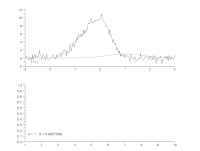
Photo from wikipedia
Abstract Human kallikrein-kinin system (KKS) is a proteolytic cascade with two serine-protease zymogen couples (Factor XII and prekallikrein (PK) and their activated forms, FXIIa, PKa, respectively), releasing bradykinin by cleavage… Click to show full abstract
Abstract Human kallikrein-kinin system (KKS) is a proteolytic cascade with two serine-protease zymogen couples (Factor XII and prekallikrein (PK) and their activated forms, FXIIa, PKa, respectively), releasing bradykinin by cleavage of native high-molecular-weight kininogen (nHK) into cleaved HK. For KKS investigation in human plasma, this cascade is usually triggered on ice eventually by mixing with purified proteins. It has been established that purified FXIIa, PK, and nHK required a fixed order and timing for mixing protein on ice to ensure reproducibility of testing, we investigated the activation kinetics of both enzymes. The activation process of this in vitro minimal reconstitution of KKS was studied by progress curve analysis, in condition of high enzyme/substrate ratio and by using on natural rather than peptide substrates. FXIIa and PKa were found five-times less active on ice than at 37°C: kcat = 0.133 ± 0.034 and 0.0119 ± 0.0027 s−1, KM = 672 ± 150 and 115 ± 24 nM, respectively. The progress curve analysis of our in vitro KKS reconstitutions differed from a Michaelis–Menten mathematical simulation by a faster initial rate and a slower late rate. These two features were also observed ex vivo by using dextran sulfate-activated plasma and could reinforce the hypothesis of a maximal local effect (bradykinin release) and a minimal systemic consequence (PK preservation) in KKS activation process. Analyzing the complete curve of cold KKS activation would provide valuable information for ex vivo investigation of KKS in samples from patients presenting with hereditary angioedema and other inflammatory conditions.
Journal Title: Bioscience Reports
Year Published: 2022
Link to full text (if available)
Share on Social Media: Sign Up to like & get
recommendations!